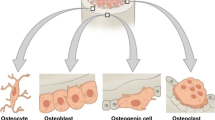Summary
Tissue-engineering bone with porous β-tricalcium phosphate (β-TCP) ceramic and autologous bone marrow mesenchymal stem cells (MSC) was constructed and the effect of this composite on healing of segmental bone defects was investigated. 10–15 ml bone marrow aspirates were harvested from the iliac crest of sheep, and enriched for MSC by density gradient centrifugation over a Percoll cushion (1.073 g/ml). After cultured and proliferated, tissue-engineering bones were constructed with these cell seeded onto porous β-TCP, and then the constructs were implanted in 8 sheep left metatarsus defect (25 mm in length) as experimental group. Porous β-TCP only were implanted to bridge same size and position defects in 8 sheep as control group, and 25 mm segmental bone defects of left metatarsus were left empty in 4 sheep as blank group. Sheep were sacrificed on the 6th, 12th, and 24th week postoperatively and the implants samples were examined by radiograph, histology, and biomechanical test. The 4 sheep in blank group were sacrificed on the 24th or histologically at the defects of experimental group as early as 6th week postoperatively, but not in control group, and osteoid tissue, woven bone and lamellar bone occurred earlier than in control group in which the bone defects were repaired in “creep substitution” way, because of the new bone formed in direct manner without progression through a cartilaginous intermediate. At the 24th week, radiographs and biomechanical test revealed an almost complete repair of the defect, of experimental group, only partly in control group. The bone defects in blank group, were non-healing at the 24th week. It was concluded that engineering bones constructed with porous β-TCP and autologous MSC were capable of repairing segmental bone defects in sheep metatarsus beyond “creep substitution” way and making it, healed earlier. Porous β-TCP being constituted with autologous MSC may be a good option in healing critical segmental bone defects in clinical practice and provide insight for future clinical repair of segmental defect.
Similar content being viewed by others
References
Sasso R C, Williams J I, Dimasi Net al. Postoperative drains at the donor sistes of iliac-crest bone grafts. A prospective, randomized study of morbidity at the donor site in patients who had a traumatic injury of the spine. J Bone Joint Surg Am, 1998, 80(5): 631
Pittenger M F, Mackay A M, Beck S Cet al. Multilineage potential of adult human MSC. Science, 1999, 284 (5411): 143
Bo B, Wang C Y, Guo X M. Repair of cranial defects with bone marrow derlved MSC and beta-TCP scaffold in rabbits. Zhongguo Xiu Fu Chong Jian Wai Ke Za Zhi (Chinese), 2003, 17(4): 335
Lu J X, Gallur A, Flautre Bet al. Comparative study of tissue reactions to calcium phosphate ceramics among cancellous, cortical, and medullar bone sites in rabbits. J Biomed Mater Res, 1998, 42(3): 357
Kadiyala S, Young R G, Thiede M Aet al. Culture expanded canine MSC posses osteochondrogenic potential in vivo and in vitro. Cell Transplant, 1997, 6(2): 125
Ohgushi H, Goldberg V M, Caplan A I. Repair of bone defects with marrow cells and porous ceramic. Experiments in rats. Acta Orthop Scand, 1989, 60(3): 334
Kruyt M C, de Bruijn J D, Wilson C Eet al. Viable osteogenic cells are obligatory for tissue-engineered ectopic bone formation in goats. Tissue Eng, 2003, 9(2): 327
Dong J, Uemura T, Shirasaki Yet al. Promotion of bone formation using highly pure porous beta-TCP combined with bone marrow-derived osteoprogenitor cells. Biomaterials, 2002, 23(23): 4493
Petite H, Viateau V, Bensaid Wet al. Tissue-engineered bone regeneration. Nat Biotechnol, 2000, 18(9): 959
Gao T J, Lindholm T S, Kommonen Bet al. Enhanced healing of segmental tibial defects in sheep by a composite bone substitute composed of tricalcium phosphate cylinder, bone morphogenetic protein, and type IV collagen. J Biomed Mater Res, 1996, 32(4): 505
Author information
Authors and Affiliations
Additional information
LI Zhanghua, male, born in 1973, M.D., Ph.D.
This project was supported by national high technology research and development program of China (863 Program, 2001AA216031), key technologies research and development program of Beijing (H020920050031).
Rights and permissions
About this article
Cite this article
Zhanghua, L., Yi, Y., Changyong, W. et al. Repair of sheep metatarsus defects by using tissue-engineering technique. Current Medical Science 25, 62–67 (2005). https://doi.org/10.1007/BF02831389
Received:
Published:
Issue Date:
DOI: https://doi.org/10.1007/BF02831389




